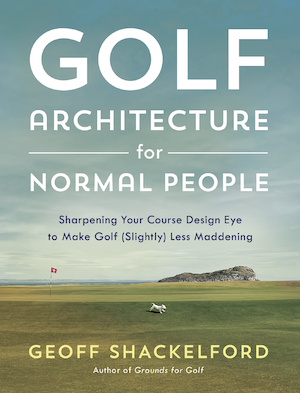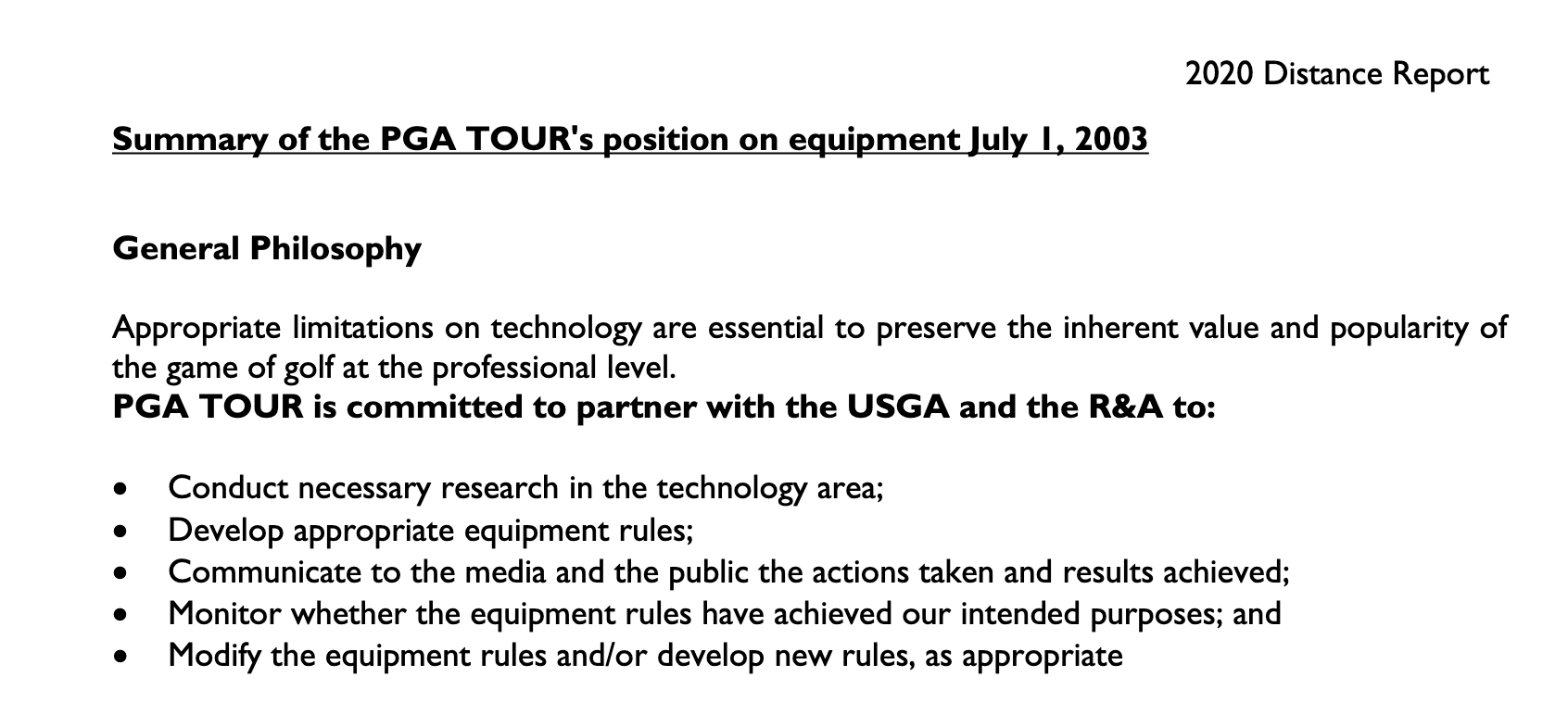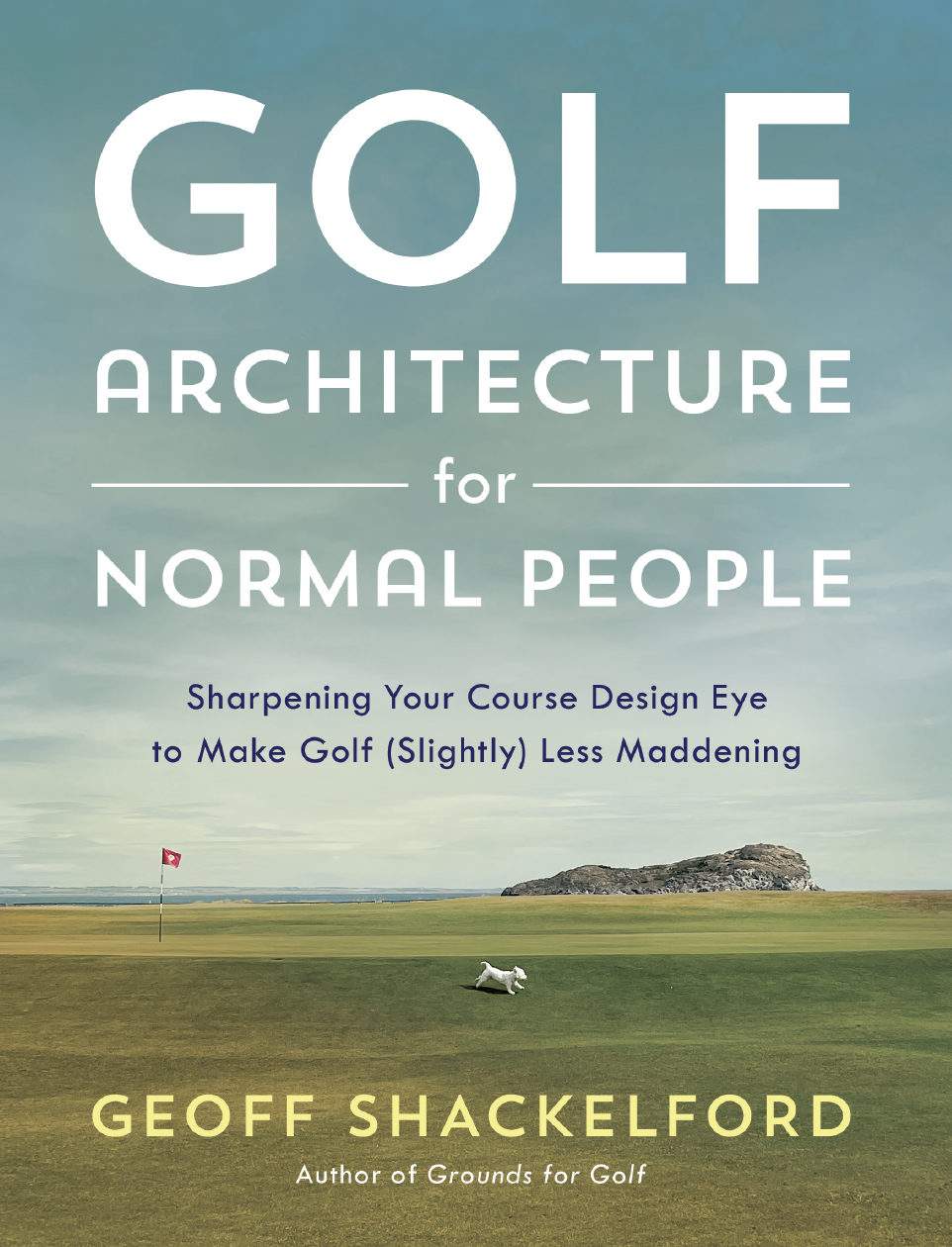We have a lot to get to! For now, the press release says a lot. With, admittedly, a fun buried lede.
The USGA and R&A Announce Golf Equipment Research Topics and Proposed Equipment Standards Changes
Research topics include potential Local Rule and review of club and ball specifications
to help mitigate continuing distance increases
Proposed changes to current Equipment Standards on club length, test conditions for golf ball testing and tolerances for club spring-like effect to ensure effectiveness in relation to distance limits
LIBERTY CORNER, N.J., USA and ST. ANDREWS, Scotland (Feb. 2, 2021) – The USGA and The R&A are re-engaging with the golf industry on the Distance Insights project, which aims to help achieve a more sustainable long-term future for golf.
Strong lede.
The governing bodies are issuing specific Areas of Interest to help mitigate continuing distance increases and three proposed changes to the Equipment Rules to ensure their effectiveness in relation to distance limits.
Areas of Interest=Person of Interest.
The delivery of research topics related to hitting distances and golf’s sustainability was delayed in 2020 to allow the golf industry to focus on the impact of the global COVID-19 pandemic.
The Areas of Interest notice, sent on Monday to golf equipment manufacturers, follows the conclusions of the Distance Insights Report delivered last February. It is the first step of the established Equipment Rulemaking Procedures, which give the opportunity for golf’s stakeholders to provide research and perspectives on topics that might lead to equipment Rules changes.
In addition, three proposals related to Equipment Standards were also sent to the manufacturers yesterday and have been published – two to modernize equipment testing protocols and the other to consider the adoption of a Model Local Rule that would provide flexibility for committees, if they so choose, to limit the maximum length for clubs other than putters from 48 to 46 inches. Notice and comment periods have begun immediately to invite feedback on each of the three proposals from golf industry stakeholders.
The Model Local Rule. Also none as, a gift to Augusta National’s stately 13th tee pines that will live to see many more Masters and allow Bryson DeChambeau to say he’s been unfairly targeted. Maybe.
It’s a little too targeted and personal. Which might be the goal given that I see early reports by those who had the embargoed version of this leading with DeChambeau targeting in their headlines. Could backfire. Or could be a brilliant bait and switch to protect the big ticket changes.
Research Topics/Areas of Interest
Document link: Official USGA/R&A Document
(Research due by Nov. 2, 2021)
The Areas of Interest notice addresses two specific Areas of Interest:
That is bifurcation whether they will call it such or not. Not that there’s anything wrong with that.
A review of the overall conformance specifications for both clubs and balls, including specifications that both directly and indirectly affect hitting distances. This review would consider whether any existing specifications should be adjusted or any new specifications created to help mitigate continuing distance increases. It would not consider revising the overall specifications to produce substantial reductions in hitting distances at all levels of the game. A list of club and ball specifications to be reviewed can be found in the official notice.
Stakeholders are invited to participate in the process by sharing any data or perspectives they might have on these topics by Nov. 2, 2021.
Oh so much time to rack up billable hours!
The topics are purely areas for research. No solutions or decisions are being proposed at this stage. Any proposals for Rule changes that might result from this research will be communicated in accordance with the Equipment Rulemaking Procedures.
Proposed Equipment Standards changes
The USGA and The R&A are addressing the effectiveness of current equipment-testing processes, protocols and standards with respect to distance limits. As a result, the governing bodies are seeking comment from equipment manufacturers on three proposed Equipment Standards changes, as follows:
Proposal #1: Club length – reduction to 46 inches available as a Model Local Rule (MLR) (Original proposal delivered in 2016 and paused in 2017 due to the Distance Insights Project). Comment period ends on March 4, 2021.
And on March 5th…sorry, go on.
Proposal #2: Update on testing method for golf balls. Comment period ends on Aug. 2, 2021.
Proposal #3: Change to testing tolerance – Characteristic Time. Comment period ends on Aug. 2, 2021.
These items were telegraphed in the Distance Insights report, so should come as little surprise to manufacturers.
The 2020 Annual Driving Distance Report
The USGA and The R&A also today released the 2020 Annual Driving Distance Report. The full report can be found here: Report Link
Key quotes
Mike Davis, Chief Executive Officer of the USGA, said, “The research conducted through Distance Insights clearly shows that hitting distances have consistently increased through time and, if left unchecked, could threaten the long-term future of our game at every level and every golf course on which it is played. This is the first forward step in a journey and a responsibility the USGA and The R&A share with the worldwide golf community, to ensure that golf continues to thrive for the next hundred years and beyond.”
Martin Slumbers, Chief Executive of The R&A, said, “We are now able to progress with the work on this critical topic and are beginning the next phase as expeditiously as possible. The research topics and the proposed changes we have announced will be the focus of our attention in the coming months and we look forward to gaining insights from the golf industry and fully understanding their perspectives on these key areas. We remain fully committed to conducting this hugely important exercise for the sport thoroughly, efficiently and collaboratively.”
Strongest quotes yet. They’ve made up their minds. Let the whining begin!
And now for your buried lede.
Updates Since February 2020
During the pause in distance-related research caused by the COVID-19 pandemic, the USGA and The R&A completed their regular review of equipment-testing processes, protocols and standards to ensure their effectiveness in relation to distance limits. The proposals detailed above are the outcome of this regular review of equipment-testing processes, protocols and standards to ensure their effectiveness.
As such, these proposals were not conceived and are not intended to be solutions to the distance issues identified in the Distance Insights Report.
But we did add the 46-inch driver rule based on what we were seeing.
The summary below of the issue at hand is also quite well said.
All notices related to golf equipment follow the Equipment Rulemaking Procedures adopted in 2011 by the USGA, The R&A and golf equipment manufacturers, which provide an open process of dialogue for all involved. The procedures can be reviewed here.
The Distance Insights Report released last year highlighted the impact of long-term hitting distance increases on some of golf’s essential elements, including changing the strategic challenge of the game, altering the variety of skills needed to be successful and risking courses becoming less challenging or obsolete. Further, the report states that the overall trend of golf courses becoming longer has adverse consequences that ultimately affect golfers at all levels of the game. The governing bodies are working with the key stakeholders in golf to address these issues in a way that brings the game together and which ensures it will continue to thrive for many years to come.
Work is also currently being conducted to develop industry-wide recommendations and best management practices on course design, setup and course conditions related to distance for all golf courses and golfers, as detailed among next steps in the Distance Insights conclusions document delivered last year. The USGA is currently conducting field testing and research, with outcomes to be delivered throughout 2021.
And there you go. Easily the most confident statements we’ve ever seen from the governing bodies.




















